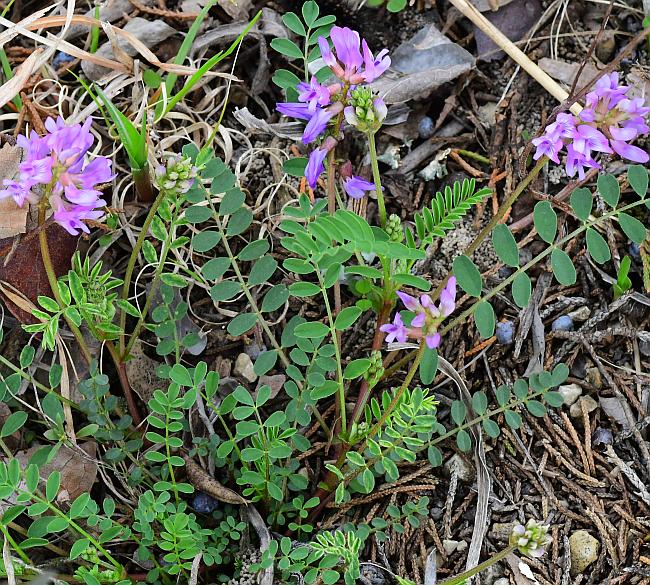Astragalus distortus Torr. & A. Gray
Ozark Milk Vetch

Native
CC = 6
CW = 5
MOC = 49
© SRTurner
Astragalus distortus Torr. & A. GrayOzark Milk Vetch | |
 |
Native CC = 6 CW = 5 MOC = 49 |
© SRTurner |
|
Family - Fabaceae/Faboideae Habit - Perennial herb with woody base and stout taproot. Stems - Prostrate to weakly ascending from a spreading base, to 25 cm, multiply branched, green to reddish, glabrous toward the base, sparsely pubescent with appressed straight hairs. Leaves - Alternate, odd-pinnately compound, petiolate, stipulate. Petioles 5-20 mm long, with 11-23 leaflets, the rachis 6-10 cm long. Stipules 2-6 mm long, free from the petiole and not sheathing the stem, lanceolate to ovate, tapered to a sharply pointed tip, membranous when young, papery at maturity. Leaflets 3-11 mm long, 2-4 mm wide, obovate to elliptic-oblanceolate, rounded to truncate to shallowly notched at the tip, the upper surface glabrous, the undersurface sparsely pubescent with appressed, unbranched hairs or occasionally glabrous.
Inflorescence - Short, spikelike racemes or appearing as capitate clusters, 2-10 cm long, the stalk 3-10 cm long, with 5-15 flowers, the bracts 2-3 mm long, usually hairy.
Flowers - Papilionaceous, spreading to somewhat drooping, the stalks 1-2 mm long, hairy. Calyces with the tube 2-3 mm long, narrowly bell-shaped, slightly pouched, pubescent with black and/or white, unbranched, mostly appressed hairs, the lobes 1.0-1.5 mm long, narrowly triangular. Corollas light purple to purple, often whitish toward the base, occasionally all white, the banner 10-14 mm long, 4-5 mm wide, somewhat curved or bent upward, the wings 7-11 mm long, the keel 6-9 mm long. Stamens with the fused portion 5-6 mm long, the free portion 1-2 mm long. Styles 6-8 mm long.
Fruits - Legumes 15-28 mm long, 4-5 mm wide, cylindric, short-tapered to a short beak at the tip, strongly arched or curved, not or only slightly inflated, leathery at maturity, ascending to spreading, 1-locular, glabrous, often reddish- to purplish-tinged when young, dehiscent tardily or more commonly indehiscent (dehiscing through decay after being shed). Seeds 1.5-2.5 mm long, the surface brown to reddish brown, smooth or with faint, coarse wrinkles.
Flowering - April - June. Habitat - Upland prairies, sand prairies, glades, ledges, forest openings, pastures, roadsides. Origin - Native to the U.S. Lookalikes - Vicia villosa. Other info. - This plant is found across much of Missouri, but is rare to absent in the northwestern and southeastern corners of the state. The species has been subdivided into two varieties, neither of which is particularly common. Missouri plants belong to var. distortus, which is mainly restricted to 6 states centered on Missouri. There is a disjunct population in Virginia and W. Virginia, where it is considered rare. In Missouri the plant is easily identified by its small and non-vining habit, and small inflorescences of purple flowers (these can occasionally be white, however). Photographs taken at Valley View Glade Natural Area, Jefferson County, MO, 4-24-2009, Don Robinson State Park, Jefferson County, MO, 4-26-2019, Cuivre River State Park, Lincoln County, MO, 5-9-2019, and Shaw Nature Reserve, Franklin County, MO, 4-24-2022 (SRTurner). |